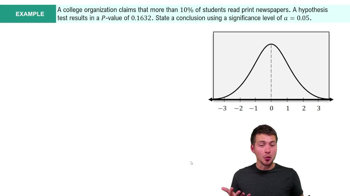Gender and Eye Color The following table describes the distribution of eye colors reported by male and female statistics students (based on data from “Does Eye Color Depend on Gender? It Might Depend on Who or How You Ask,” by Froelich and Stephenson, Journal of Statistics Education, Vol. 21, No. 2). Is there sufficient evidence to warrant rejection of the belief that gender and eye color are independent traits? Use a 0.01 significance level.
Table of contents
- 1. Intro to Stats and Collecting Data1h 14m
- 2. Describing Data with Tables and Graphs1h 55m
- 3. Describing Data Numerically2h 5m
- 4. Probability2h 16m
- 5. Binomial Distribution & Discrete Random Variables3h 6m
- 6. Normal Distribution and Continuous Random Variables2h 11m
- 7. Sampling Distributions & Confidence Intervals: Mean3h 23m
- Sampling Distribution of the Sample Mean and Central Limit Theorem19m
- Distribution of Sample Mean - Excel23m
- Introduction to Confidence Intervals15m
- Confidence Intervals for Population Mean1h 18m
- Determining the Minimum Sample Size Required12m
- Finding Probabilities and T Critical Values - Excel28m
- Confidence Intervals for Population Means - Excel25m
- 8. Sampling Distributions & Confidence Intervals: Proportion1h 12m
- 9. Hypothesis Testing for One Sample3h 29m
- 10. Hypothesis Testing for Two Samples4h 50m
- Two Proportions1h 13m
- Two Proportions Hypothesis Test - Excel28m
- Two Means - Unknown, Unequal Variance1h 3m
- Two Means - Unknown Variances Hypothesis Test - Excel12m
- Two Means - Unknown, Equal Variance15m
- Two Means - Unknown, Equal Variances Hypothesis Test - Excel9m
- Two Means - Known Variance12m
- Two Means - Sigma Known Hypothesis Test - Excel21m
- Two Means - Matched Pairs (Dependent Samples)42m
- Matched Pairs Hypothesis Test - Excel12m
- 11. Correlation1h 6m
- 12. Regression1h 50m
- 13. Chi-Square Tests & Goodness of Fit1h 57m
- 14. ANOVA1h 57m
9. Hypothesis Testing for One Sample
Steps in Hypothesis Testing
Problem 11.q.1
Textbook Question
Exercises 1–5 refer to the sample data in the following table, which summarizes the frequencies of 500 digits randomly generated by Statdisk. Assume that we want to use a 0.05 significance level to test the claim that Statdisk generates the digits in a way that they are equally likely.

What are the null and alternative hypotheses corresponding to the stated claim?
 Verified step by step guidance
Verified step by step guidance1
Step 1: Understand the problem. The goal is to test the claim that Statdisk generates digits in a way that they are equally likely. This involves setting up hypotheses for a chi-square goodness-of-fit test.
Step 2: Define the null hypothesis (H₀). The null hypothesis states that the digits are equally likely to occur, meaning the expected frequency for each digit is the same. Mathematically, H₀: P(0) = P(1) = P(2) = ... = P(9).
Step 3: Define the alternative hypothesis (H₁). The alternative hypothesis states that the digits are not equally likely to occur, meaning at least one digit has a different probability. Mathematically, H₁: At least one P(i) ≠ P(j) for i ≠ j.
Step 4: Calculate the expected frequency for each digit under the null hypothesis. Since there are 500 total digits and 10 possible digits, the expected frequency for each digit is 500 ÷ 10 = 50.
Step 5: Use the observed frequencies from the table and the expected frequencies to compute the chi-square test statistic. The formula for the chi-square test statistic is χ² = Σ((Oᵢ - Eᵢ)² / Eᵢ), where Oᵢ is the observed frequency and Eᵢ is the expected frequency for each digit.
 Verified video answer for a similar problem:
Verified video answer for a similar problem:This video solution was recommended by our tutors as helpful for the problem above
Video duration:
2mPlay a video:
Was this helpful?
Key Concepts
Here are the essential concepts you must grasp in order to answer the question correctly.
Null Hypothesis (H0)
The null hypothesis is a statement that assumes no effect or no difference, serving as a default position in hypothesis testing. In this context, it posits that the digits generated by Statdisk are equally likely, meaning each digit from 0 to 9 has the same probability of occurrence. This hypothesis is tested against the alternative hypothesis to determine if there is enough evidence to reject it.
Recommended video:
Guided course

Step 1: Write Hypotheses
Alternative Hypothesis (H1)
The alternative hypothesis is a statement that contradicts the null hypothesis, suggesting that there is an effect or a difference. For this scenario, the alternative hypothesis would claim that the digits generated by Statdisk are not equally likely, indicating that some digits occur more frequently than others. This hypothesis is what researchers aim to support through statistical testing.
Recommended video:
Guided course

Step 1: Write Hypotheses
Significance Level (α)
The significance level, denoted as alpha (α), is the threshold for determining whether to reject the null hypothesis. In this case, a significance level of 0.05 indicates that there is a 5% risk of concluding that a difference exists when there is none. If the p-value obtained from the statistical test is less than 0.05, the null hypothesis would be rejected in favor of the alternative hypothesis.
Recommended video:
Guided course

Step 4: State Conclusion Example 4

 6:21m
6:21mWatch next
Master Step 1: Write Hypotheses with a bite sized video explanation from Patrick
Start learningRelated Videos
Related Practice
Textbook Question
